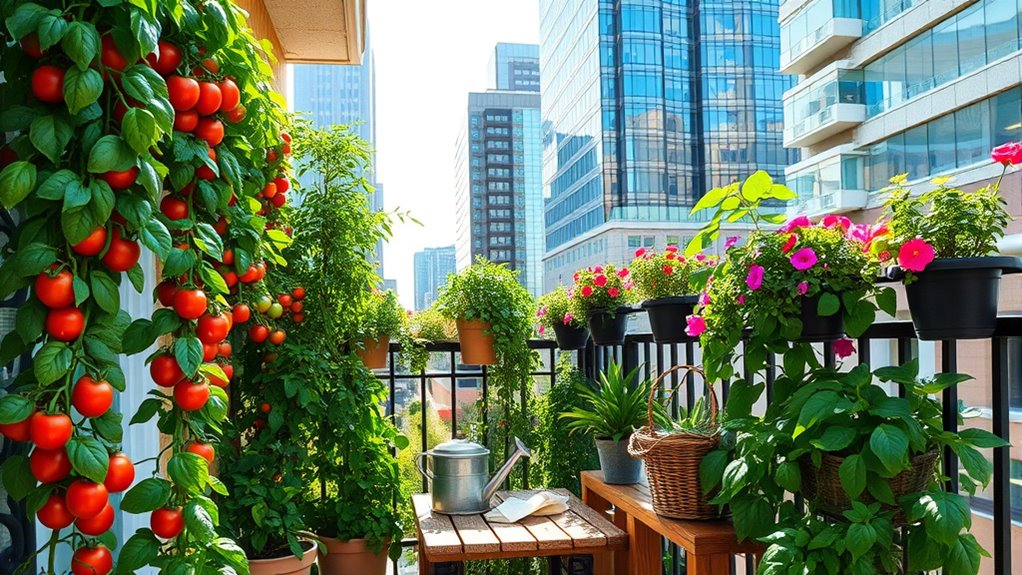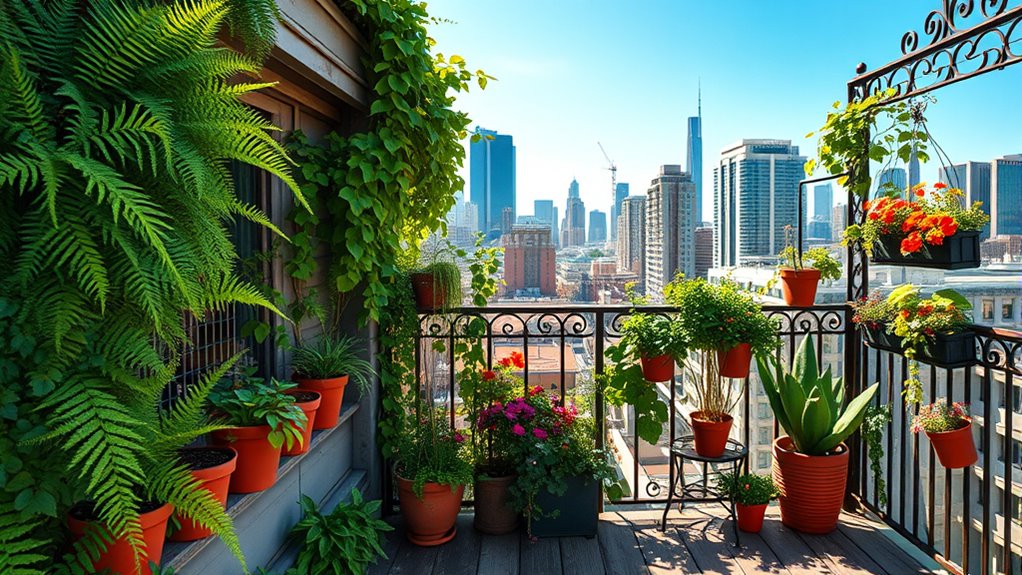Transform your balcony into a lush garden with vertical planting techniques that make the most of limited space. Use wall-mounted planters, hanging baskets, and tiered shelves to create a vibrant green oasis. Choose lightweight, durable containers with good drainage, and position plants based on sunlight needs. Regular watering and smart arrangement make maintenance easier. Keep weather conditions in mind to guarantee longevity. Explore more tips to turn your balcony into a flourishing outdoor escape.
Key Takeaways
- Maximize space with vertical planting using wall-mounted planters, hanging baskets, and tiered shelves.
- Select lightweight, durable containers with proper drainage to support healthy plant growth.
- Arrange plants based on sunlight needs and accessibility for easy maintenance and harvesting.
- Use weather-resistant containers and elevate them to improve drainage and extend durability outdoors.
- Incorporate a variety of plants—herbs, flowers, vegetables—to create a lush, productive balcony garden.

Have you ever wondered how to turn limited city spaces into lush, productive gardens? If you’re looking to maximize your balcony’s potential, vertical planting is your best friend. It allows you to grow more in less space by using wall-mounted planters, hanging baskets, and tiered shelves. Vertical planting not only saves floor space but also creates a stunning visual effect, transforming your balcony into a green oasis. When considering vertical planting, think about the types of plants you want to grow—herbs, flowers, or vegetables—and choose appropriate containers that can support their weight and needs.
Maximize small balcony spaces with vertical planting using wall-mounted planters, baskets, and shelves.
Container selection plays an essential role in successful balcony gardening. Opt for containers that are durable, lightweight, and have adequate drainage to prevent waterlogging. Materials like plastic, resin, or lightweight ceramic work well because they’re easy to move and withstand weather changes. Size matters, too. Smaller containers are suitable for herbs and small plants, but for larger vegetables or fruiting plants, go for bigger pots to give roots enough space to grow. Think about the height, width, and depth—the more room your plants have, the healthier they’ll be.
Position your containers carefully, considering sunlight and wind exposure. Place taller plants or those needing more sun in spots where they can get ample light, and use smaller or shade-tolerant plants in shaded areas. When arranging containers, keep accessibility in mind; you’ll want to reach all your plants easily for watering, pruning, and harvesting. Grouping plants with similar water and sunlight needs together simplifies maintenance.
Watering is another pivotal factor. Containers tend to dry out faster than ground soil, so you’ll need to check moisture levels regularly. Using self-watering containers can help maintain consistent hydration, reducing your workload. Also, consider the aesthetic when selecting containers—coordinating colors and styles can create a cohesive, inviting look. Additionally, choosing high-quality containers can improve durability and plant health over time.
Lastly, think about how your containers and vertical elements will withstand weather changes. Look for materials resistant to rust, rot, or fading, especially if your balcony is exposed to harsh sunlight or rain. Elevate your containers slightly off the ground to prevent water damage and improve drainage. With thoughtful container selection and strategic vertical planting, your balcony can become a thriving, beautiful retreat. Embrace the challenge, experiment with different setups, and enjoy the satisfaction of growing your own fresh herbs, flowers, or vegetables right outside your door.
Frequently Asked Questions
What Are the Best Plants for Limited Balcony Space?
You should choose compact, easy-to-maintain plants like herbs, succulents, and small vegetables for limited balcony space. Opt for containers that suit your plant’s needs, ensuring proper drainage and size. Incorporate vertical gardening techniques, like wall planters or hanging pots, to maximize space. These strategies help you grow a variety of plants comfortably, making your balcony lush and productive without overcrowding.
How Do I Prevent Pests on Balcony Plants?
To prevent pests on your balcony plants, start with companion planting; it naturally repels pests and attracts beneficial insects. Keep your plants healthy by regularly inspecting for signs of pests and removing affected leaves. Use organic pesticides as a safe, eco-friendly option when needed, avoiding harsh chemicals. Additionally, maintain good airflow and avoid overwatering, which can create a hospitable environment for pests. Consistent care keeps your balcony garden thriving.
What Are Cost-Effective Materials for Building Balcony Garden Beds?
You can save money by using recycled materials like old wooden pallets, plastic containers, or tin cans for your balcony garden beds—these are great DIY planter ideas that won’t break the bank. Just remember, a penny saved is a penny earned, so get creative with repurposing items you already have. These cost-effective options are easy to customize and add a charming touch to your balcony garden.
How Can I Ensure Proper Drainage on a Balcony?
To guarantee proper drainage on your balcony, you should start with effective drainage solutions like installing a layer of gravel or coarse soil at the bottom of your garden beds. Manage balcony slope by tilting the beds slightly towards drainage points to prevent water pooling. Regularly check for clogged drainage holes and avoid overwatering. These steps help protect your plants and keep your balcony dry and healthy.
What Are the Legal Regulations for Urban Balcony Gardening?
You need to verify local zoning laws and building regulations for urban balcony gardening. Some areas require permits or have restrictions on plant height and safety. To maintain balcony privacy and reduce urban noise, consider installing privacy screens or planting dense greenery. Make sure your setup complies with weight limits and safety codes. Staying informed ensures you enjoy your garden while respecting legal boundaries and enhancing your outdoor space.
Conclusion
Imagine your balcony bursting into life, a tiny sanctuary where your green thumb paints a vibrant masterpiece against the city’s gray backdrop. With each seed you plant, you’re cultivating more than just plants—you’re growing a slice of serenity and fresh abundance right outside your door. So, embrace the chaos of city sounds and let your balcony blossom into a lush, edible oasis, transforming your space into a vibrant, living mosaic of nature’s beauty.










